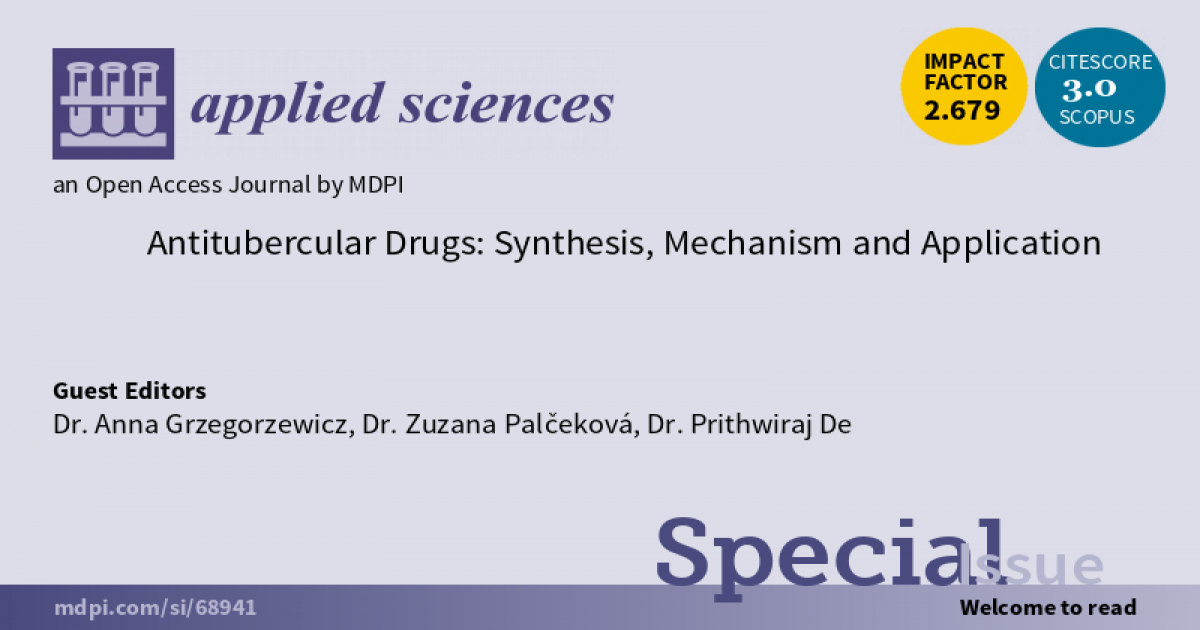- 2.5Impact Factor
- 5.5CiteScore
- 17 daysTime to First Decision
Antitubercular Drugs: Synthesis, Mechanism and Application
This special issue belongs to the section “Applied Biosciences and Bioengineering“.
Special Issue Information
Dear Colleagues,
Tuberculosis, caused by Mycobacterium tuberculosis, remains a major public health problem worldwide and is responsible for nearly 1.5 million deaths annually. The increase of tuberculosis cases in recent years is related to an emergence of multidrug-resistant and extensive drug-resistant strains of M. tuberculosis and the AIDS pandemic. Although tuberculosis is a curable disease, its treatment requires multidrug and lengthy therapy associated with severe adverse effects, often leading to poor patient adherence. In the last two decades, great progress in tuberculosis drug discovery has been made while searching for the most suitable approach to lead generation. Although there are currently several drug candidates in the late stages of development and new drugs have been recently introduced into the antitubercular drug regimen, more compounds presenting a better efficacy, less-toxicity, and targeting different subpopulations of M. tuberculosis, which, simultaneously, are not affected by the existing resistance mechanisms, are certainly urgently needed. This is approached by both the discovery of new molecular scaffolds and reposing the old antitubercular drugs.
In this Special Issue, we invite submissions exploring tuberculosis drug discovery including, but not limited to, the synthesis, mode of action, and determining the efficacy of compounds. Reviews and original research papers are welcome.
Dr. Anna Grzegorzewicz
Dr. Zuzana Palčeková
Dr. Prithwiraj De
Guest Editors
Manuscript Submission Information
Manuscripts should be submitted online at www.mdpi.com by registering and logging in to this website. Once you are registered, click here to go to the submission form. Manuscripts can be submitted until the deadline. All submissions that pass pre-check are peer-reviewed. Accepted papers will be published continuously in the journal (as soon as accepted) and will be listed together on the special issue website. Research articles, review articles as well as short communications are invited. For planned papers, a title and short abstract (about 250 words) can be sent to the Editorial Office for assessment.
Submitted manuscripts should not have been published previously, nor be under consideration for publication elsewhere (except conference proceedings papers). All manuscripts are thoroughly refereed through a single-blind peer-review process. A guide for authors and other relevant information for submission of manuscripts is available on the Instructions for Authors page. Applied Sciences is an international peer-reviewed open access semimonthly journal published by MDPI.
Please visit the Instructions for Authors page before submitting a manuscript. The Article Processing Charge (APC) for publication in this open access journal is 2400 CHF (Swiss Francs). Submitted papers should be well formatted and use good English. Authors may use MDPI's English editing service prior to publication or during author revisions.
Keywords
- tuberculosis
- tuberculosis drug discovery
- drug synthesis
- hit and lead generation
- compounds screening
- minimal inhibitory concentration
- pharmacokinetic properties
- drug target
- mode of action
- intrinsic and acquired resistance
- persisters
- antitubercular drug regimen
- drug development pipeline

Benefits of Publishing in a Special Issue
- Ease of navigation: Grouping papers by topic helps scholars navigate broad scope journals more efficiently.
- Greater discoverability: Special Issues support the reach and impact of scientific research. Articles in Special Issues are more discoverable and cited more frequently.
- Expansion of research network: Special Issues facilitate connections among authors, fostering scientific collaborations.
- External promotion: Articles in Special Issues are often promoted through the journal's social media, increasing their visibility.
- e-Book format: Special Issues with more than 10 articles can be published as dedicated e-books, ensuring wide and rapid dissemination.

